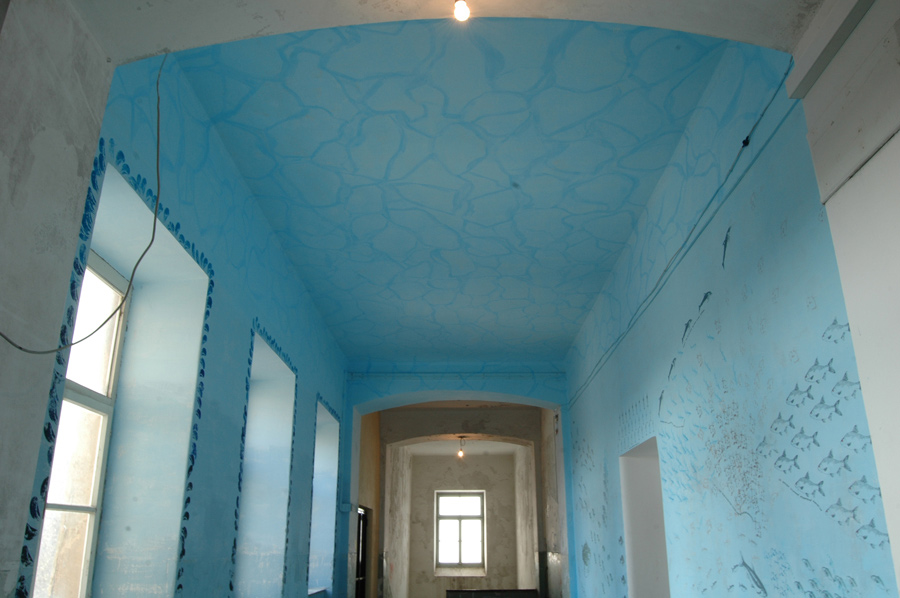Cultural Center Karl Roic in Pula, Croatia
Hallway design former K.u.K military building, wall painting, screen printing on wall
approx. 10 x 5 x 5 m
The work K.u.K. Aquarium GrazPula was created as part of the art project murwillmeer! in September 2012. In celebration of the 40th anniversary of the city partnership between Graz and Pula, artists from Graz were invited to develop artworks for the Karl Rojc Cultural, Art, and Social Center in Pula. These works are permanently displayed in the corridors of the former K.u.K. military building on the fifth floor.
For centuries, Pula was the most strategically important port of the Austro-Hungarian Empire. Numerous former military buildings still testify to this function. The current use of these buildings is diverse: one fortification, for example, was successively used as a hotel, disco, and shopping mall, and now houses the Pula Aquarium.
The Graz city website describes the connection to Pula as „pragmatic“ – the city of Graz maintained a children’s home in Pula until World War II. This children’s home is also linked to the former K.u.K. military barracks. Both institutions likely shared a similar character in terms of location and organization: long corridors, large halls, uniform meals, a structured daily routine, strict rules, hierarchical structures, physical and emotional discipline…
In K.u.K. Aquarium GrazPula, fish found in the Graz Mur meet marine animals native to the area around Pula. Various creatures such as gilt-head bream, red mullet, roach, huchen, and blue sharks frolic more or less peacefully in the corridor of the Karl Rojc Center. The work also highlights another similarity between Pula and Graz: aerial bombs that lie underwater, waiting for their final orders.
The quote by Antoine de Saint-Exupéry from „Citadelle“ reflects the emotional depth resonating in this project: „The tears of that small child, if they move you, are a portal to the open sea. For it is not just these tears that move you, but all tears.“ The tears of the child and the open sea symbolize the universal and profound emotions evoked by the connection between Graz and Pula and their shared history.
Short texts accompany all the illustrations, such as:
A school of white seabream searches for the way into the net.
Two groups of John Dory have a disagreement.
The mussels eat the leftovers.
The aerial bombs calmly wait for their deployment.
The roaches swim in formation, unimpressed.
The dentex follow the yellow leader.
The two-banded seabream are bored.
The huchen are sad; in the wild, they are ten times bigger.
Eel and burbot swim together.
The grouper tries to beam itself away.
The striped seabream stand in a row.
The graylings would rather dive deeper.
Spearfish and swordfish (Iglan and Iglun) form up.
The blue sharks can comfortably wait for their food in the background.
Great-grandfather and great-grandmother show the little ones the aquarium.
Even the good-natured dolphins want to escape. T
he Venus clams try not to step out of line.
Noah’s Ark watches everything comfortably.
Srecko labinjonka, found in Pula in May 2012, injured on the neck, will be released into the wild after rehab
















